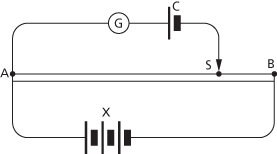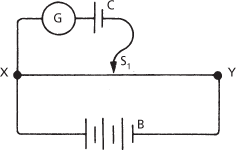1. See voltage divider.
2. An instrument for measuring, comparing, or dividing small potential differences. A typical example of its use is the measurement of the e.m.f. (E1) of a cell by comparing it with the e.m.f. (E2) of a standard cell. In this case a circuit is set up as illustrated, in which AB is a wire of uniform resistance and S is a sliding contact onto this wire. An accumulator X maintains a steady current through the wire. To measure the e.m.f. of a cell C, it is connected up as shown in the diagram and the sliding contact moved until the e.m.f. of C exactly balances the p.d. from the accumulator, as indicated by a zero reading on the galvanometer G. If the length AS is then l1, the value of E1 is given by E1/E2=l1/l2, where l2 is the length AS when the standard cell is used as the cell C.

Potentiometer.
1. A form of potential divider that uses a uniform wire as the resistive chain. A movable sliding contact is used to tap off any potential difference less than that between the ends of the wire.
A typical use is for the measurement of potential difference or e.m.f. by balancing the unknown e.m.f. with that of a standard. For example, to measure the e.m.f. of a cell, C, the cell is arranged as shown in the diagram. The slider, S, is moved along XY until the null position is found on the galvanometer, G. The e.m.f. due to C just balances the potential across XS1 (of length l1). The cell is replaced by a standard cell, CS, and the new balance point found at XS2 (length l2). Then
where EC and ES are the e.m.fs. of the unknown and standard cells, respectively.
More elaborate forms of potentiometer are available for precision applications, such as the Kelvin–Varley slide.
2. Any variable resistor, usually wire-wound, used in electronic circuits that has a third movable contact. The geometry of the device can be arranged so that the output voltage is a particular function of the applied voltage. The uniform wire can be arranged as a single coil or a spiral with the movable contact rotating about the axis through the centre of the coil. A sine, cosine, or logarithmic potentiometer produces an output proportional to the sine, cosine, or logarithm of the angular displacement of the shaft, respectively.

Potentiometer
- Traditional Stratigraphic Scale
- traducianism
- Trafalgar, Battle of (21 October 1805)
- traffic
- traffic control
- traffic intensity
- traffic logging system
- traffic segregation
- tragedy
- tragedy of the commons
- trail
- trailer label
- trailer record
- trailing edge
- trailing edge((of a pulse))
- Trail of Tears
- train
- trained band
- training
- training area
- training sample
- training sequence
- training set
- train printer
- Trajan (53–117)